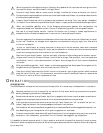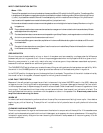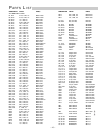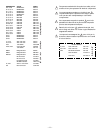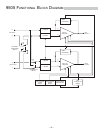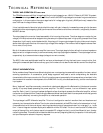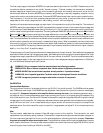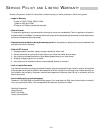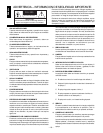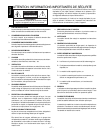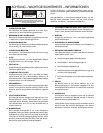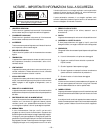
– 14 –
The final output stage utilizes lateral MOSFETs; four pairs are used for each channel in the 9505. These devices, unlike
conventional bipolar transistors do not exhibit “thermal runaway.” Thermal runaway is a phenomenon whereby a
transistor heats up as it draws more current, which causes it to get hotter, and conduct more current, and so on until
the device self destructs. Since the MOSFETs are inherently self protecting, no sonically degrading, complex circuitry
is required to monitor and protect the devices. The lateral MOSFETs also have a linear input to output transfer function.
Their connection in circuits and their operating characteristics are very similar to vacuum tubes, which is perhaps
responsible for their widely recognized sonic trait of being “musical” and non-fatiguing.
Operation of the transconductance stage is a major factor in the reproduction quality of the amplifier. The number of
MOSFETs used at the output stage of the 9505 imposes sufficient capacitive load on the transconductance stage that
if a conventional Class A stage were used (having intrinsically a 2:1 limit on peak-to-quiescent current) it would begin
to show “stress” at the higher audio frequencies. The newly perfected DIAMOND (Dynamically Invariant AMplification
Optimized Nodal Drive [patent pending]) driver stage satisfies the current headroom requirement by smoothly and
continuously varying the current transfer ratios of the two transconductance paths, under the control of the signal current
itself. This implementation allows the current transfer ratio of one path to be smoothly and continuously reduced to zero
while the other is smoothly and continuously increased by a factor of two. What is remarkably new here is that when
this normally-limiting 2:1 value is reached there is now about 14dB of additional, perfectly linear current headroom left
to drive the MOSFETs! The result is a dramatic decrease in high-frequency distortion combined with higher ultrasonic
stability – the “Holy Grail” of amplifier design.
The power supply utilizes a UI style transformer with a separate primary for each channel. The transformer has a separate
secondary for each channel high voltage power supply, each feeding a conventional split full wave bridge rectifier. High
voltage power supply capacitance is 20,000µF per rail for each channel of the 9505. The third transformer secondary
feeds a regulated supply for the input stage and driver circuitry. Low voltage power supply capacitance is 1,000µF per
rail, with additional decoupling for each channel.
WARNING: Only a competent technician should attempt the following procedure.
PRECAUCION: Sólo un técnico competente debe intentar efetuar el siguiente procedimiento.
MISE EN GARDE: Seul un technicien compétent devrait procéder à l'opération suivante.
WARNUNG: Nur ein speziell geschulter Techniker sollte die nachfolgende Prozedur durchführen.
AVVISO: La seguente procedura va eseguita soltanta da un tecnico di competenza.
CALIBRATION
Common Mode Rejection:
The input common mode null is adjusted by the trim pot R1 (R101 for the left channel). The CMRR should be greater
than 75dB below rated output. If the CMRR requires adjustment, feed the amplifier input with a common mode signal
and adjust R1. Disconnect the power to the amplifier before removing the cover. Use a sinewave generator set to 1
volt output at 1kHz. Connect the generator signal output to the tip and ring of a 1/4" plug and ground to the sleeve. Plug
this into the amplifier input. Connect an AC voltmeter to the amplifier output binding posts. Adjust R1 to give the lowest
voltage output from the amplifier. For a temporary adjustment when a signal generator and voltmeter are not available,
use an FM tuner and tune it to an unused station as your signal source, and connect the output to the amplifier as
described above. Connect the amplifier output to a small full range speaker and adjust R1 for the lowest output from
the speaker.
Bias:
The bias control establishes the quiescent Class AB output current of the amplifier. The bias should not need
readjustment from the factory setting; however, if the amplifier is repaired and output devices have been changed, or
if the two channels of the amplifier do not run at the same temperature, calibrating the bias is necessary. Disconnect
the power to the amplifier before removing the cover. To adjust the bias, disconnect the input and speakers and remove
the B+ fuse for that channel. Connect an amp meter across the now vacant fuse clips and adjust R45 (R145 for the left
channel) to get a current reading of 400mA for the 9505.



